5.1 – The Expense details
In the previous chapter, we had learnt about the revenues a company generates. Moving further on the P&L statement, in this chapter, we will look at the expense side of the Profit and Loss Statement along with the associated notes. Expenses are generally classified according to their function, which is also called the cost of sales method or based on the expense’s nature. An analysis of the expenses must be shown in the Profit and Loss statement or the notes. As you can see in the extract below, almost all the line items have a note associated with it.
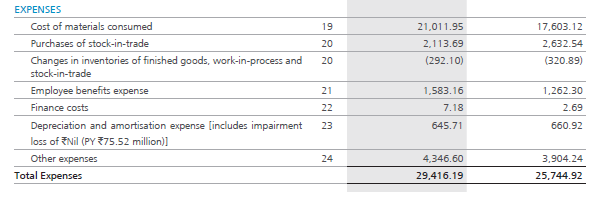
The first line item on the expense side is ‘Cost of materials consumed’; this is invariably the raw material cost that the company requires to manufacture finished goods. As you can see, the cost of raw material consumed/raw material is the company’s largest expense. This expense stands at Rs.2101 Crs for the FY14 and Rs.1760 Crs for the FY13. Note number 19 gives the associated details for this expense; let us inspect the same.

As you can see, note 19 gives us the details of the material consumed. The company uses lead, lead alloys, separators and other items, all of which adds up to Rs.2101 Crs.
The next two line items talk about ‘Purchases of Stock in Trade’ and ‘Change in Inventories of finished goods, work-in-process & stock-in-trade’. Both these line items are associated with the same note (Note 20).
Purchases of stock in the trade refer to all the purchases of finished goods that the company buys towards conducting its business. This stands at Rs.211 Crs. I will give you more clarity on this line item shortly.
Change in the inventory of finished goods refers to the costs of manufacturing incurred by the company in the past, but the goods manufactured in the past were sold in the present/current financial year. This stands at (Rs.29.2) Crs for the FY14.
A negative number indicates that the company produced more batteries in the FY14 than it managed to sell. To give a sense of proportion (in terms of sales and sales costs), the company deducts the cost incurred in manufacturing the extra goods from the current year costs. The company will add this cost when they manage to sell these extra products sometime in future. This cost, which the company adds back later, will be included in the “Purchases of Stock in Trade” line item.
Here is an extract of Note 20 which details the above two line items:
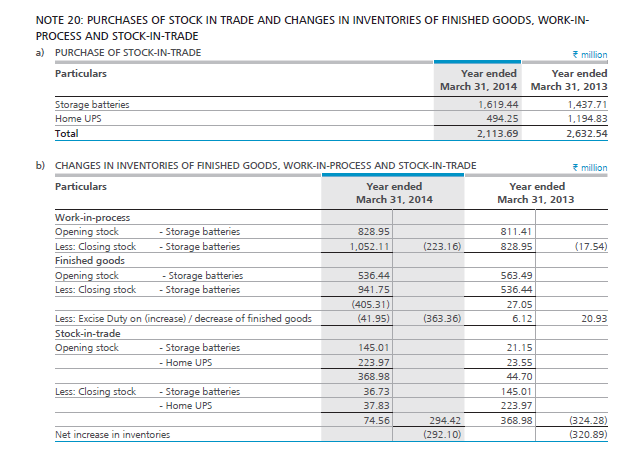
The details mentioned in the above extract are quite straightforward and is easy to understand. At this stage, it may not be necessary to dig deeper into this note. It is good to know where the total lies. However, when we take up ‘Financial Modeling’ as a separate module, we will delve deeper into this aspect.
The next line item on the expense side is “Employee Benefits Expense”. This is quite intuitive as it includes expense incurred in terms of the salaries paid, contribution towards provident funds, and other employee welfare expenses. This stands at Rs.158 Crs for the FY14. Have a look at the extract of note 21, which details the ‘Employee Benefits Expense’.

Here is something for you to think about – A company generating Rs.3482 Crs is spending only Rs.158 Crs or just 4.5% of its sales on its employees. In fact, this is the pattern across most companies (at least non IT). Perhaps it is time for you to rethink about that entrepreneurial dream you may have nurtured.
The next line item is the “Finance Cost / Finance Charges/ Borrowing Costs”. Finance cost is interest costs and other costs that an entity pays when it borrows funds. The interest is paid to the lenders of the company. The lenders could be banks or private lenders. The company’s finance cost stands at Rs.0.7 Crs for the FY14. We will discuss the debt and related matters more when we take up the chapter on the balance sheet later.
Following the finance cost, the next line item is “Depreciation and Amortization” costs which stand at Rs.64.5 Crs. To understand depreciation and amortization, we need to understand the concept of tangible and intangible assets.
A tangible asset has a physical form and provides an economic value to the company—for example, a laptop, a printer, a car, plants, machinery, buildings etc.
An intangible asset does not have a physical form but still provides an economic value to the company such as brand value, trademarks, copyrights, patents, franchises, customer lists etc.
An asset (tangible or intangible) has to be depreciated over its useful life. Useful life is defined as the period during which the asset can provide economic benefit to the company. For example, the useful life of a laptop could be 4 years. Let us understand depreciation better with the help of the following example.
Zerodha, a stockbroking firm generates Rs.100,000/- from the stockbroking business. However, Zerodha incurred Rs.65,000/- towards the purchase of a high-performance computer server. The economic life (useful life) of the server is expected to be 5 years. Now if you were to look into the earning capability of Zerodha it appears that on the one hand, Zerodha earned Rs.100,000/- and on the other hand, spent Rs.65,000/- and therefore retained just Rs.35,000/-. This skews the earnings data for the current year and does not really reflect the company’s true earning capability.
Remember the asset even though purchased this year, would continue to provide economic benefits over its useful life. Hence it makes sense to spread the cost of acquiring the asset over its useful life. This is called depreciation. This means instead of showing an upfront lump sum expense (towards the purchase of an asset), the company can show a smaller amount spread across the useful life of an asset.
Thus Rs.65,000/- will be spread across the server’s useful life, which is 5. Hence 65,000/ 5 = Rs.13,000/- would be depreciated every year over the next five years. By depreciating the asset, we are spreading the upfront cost. Hence after the depreciation computation, Zerodha would now show its earnings as Rs.100,000 – Rs.13,000 = Rs.87,000/-.
We can do a similar exercise for non-tangible assets. The depreciation equivalent for non-tangible assets is called amortization.
Here is an important idea – Zerodha depreciates the cost of acquiring an asset over its useful life. However, there is an actual outflow of Rs.65,000/- paid towards the asset purchase in reality. But now, it seems like the P&L is not capturing this outflow. As an analyst, how do we get a sense of the cash movement? The cash movement is captured in the cash flow statement, which we will understand in the later chapters.
Here is the snapshot of Note 23, detailing the depreciation cost.
 The last line item on the expense side is “other expenses” at Rs.434.6 Crs. This is a huge amount classified under ‘other expenses’. Hence it deserves a detailed inspection.
The last line item on the expense side is “other expenses” at Rs.434.6 Crs. This is a huge amount classified under ‘other expenses’. Hence it deserves a detailed inspection.
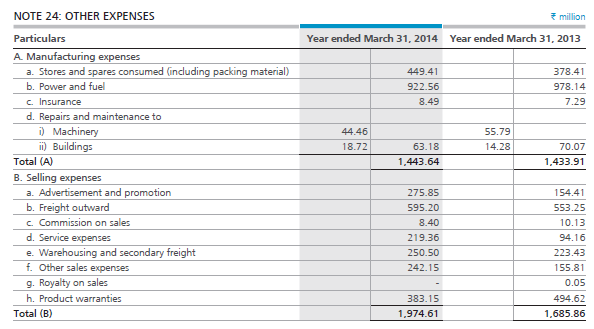
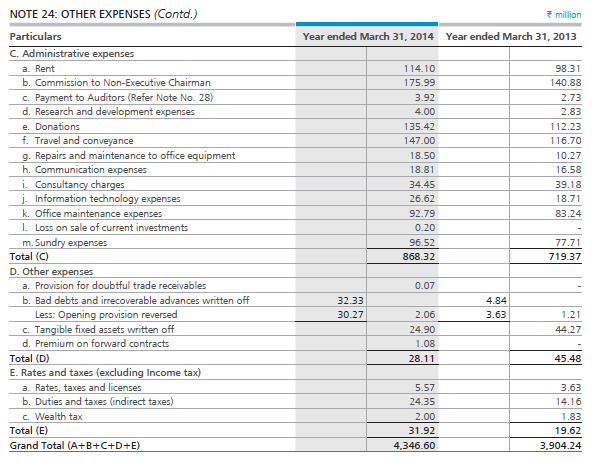
From the note, it is quite clear that other expenses include manufacturing, selling, administrative and other expenses. The details are mentioned in the note. For example, Amara Raja Batteries Limited (ARBL) spent Rs.27.5 Crs on advertisements and promotional activities.
Adding up all the expenses mentioned in the expense side of P&L, it seems that Amara Raja Batteries has spent Rs.2941.6 Crs.
5.2 – The Profit before tax
It refers to the net operating income after deducting operating expenses but before deducting taxes and interest. Proceeding further on the P&L statement, we can see that ARBL has mentioned their profit before tax and exceptional item numbers.
Put the profit before tax (PBT) is:
Profit before Tax = Total Revenues – Total Operating Expenses
= Rs.3482 – Rs.2941.6
=Rs.540.5
However, there seems to be an exceptional item/ extraordinary item of Rs.3.8 Crs, which needs to be deducted. Exceptional items/ extraordinary items are expenses occurring at one odd time for the company, and the company does not foresee this as a recurring expense. Hence they treat it separately on the P&L statement.
Hence profit before tax and extraordinary items will be:
= 540.5 – 3.88
= Rs.536.6 Crs
The snapshot below (extract from P&L) shows the PBT(Profit Before Tax) of ARBL:

5.3 – Net Profit after tax
After-tax, the net operating profit is defined as its operating profit after deducting its tax liability. We are now looking into the last part of the P&L statement, the profit after tax. This is also called the bottom line of the P&L statement.

As you can see from the snapshot above, to arrive at the profit after tax (PAT), we need to deduct all the applicable tax expenses from the PBT. Current tax is the corporate tax applicable for the given year. This stands at Rs.158 Crs. Besides this, there are other taxes that the company has paid. All taxes together total upto Rs.169.21 Crs. Deducting the tax amount from the PBT of Rs.536.6 gives us the profit after tax (PAT) at Rs.367.4 Crs.
Hence Net PAT = PBT – Applicable taxes.
The last line in the P&L statement talks about basic and diluted earnings per share. The EPS is one of the most frequently used statistics in financial analysis. EPS also serves to assess the stewardship and management role performed by the company directors and managers. The earnings per share (EPS) is a very sacred number which indicates how much the company is earning per face value of the ordinary share. It appears that ARBL is earning Rs.21.51 per share. The detailed calculation is as shown below:
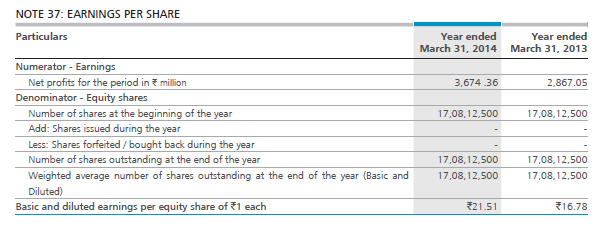
The company indicates that 17,08,12,500 shares are outstanding in the market. Dividing the total profit after tax number by the outstanding number of shares, we can arrive at the earnings per share number. In this case:
Rs.367.4 Crs divided by 17,08,12,500 yields Rs.21.5 per share.
5.4 – Conclusion
Now that we have gone through all the line items in the P&L statement, let us relook at it in its entirety.
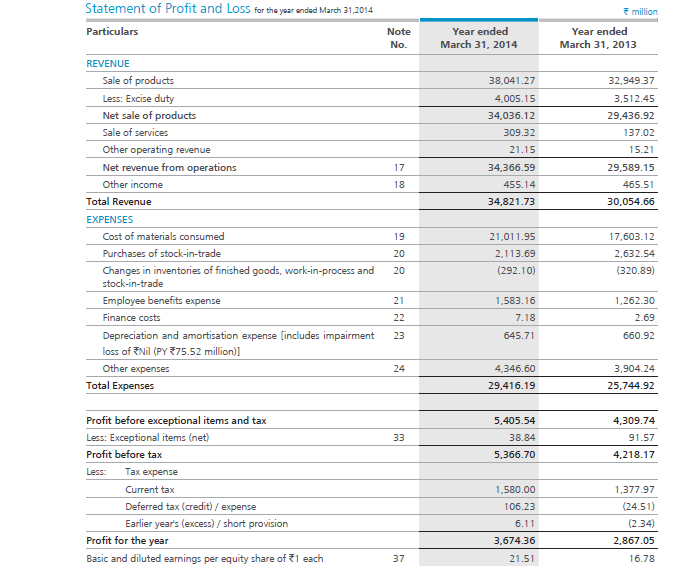
Hopefully, the statement above should look more meaningful to you by now. Remember, almost all line items in the P&L statement will have an associated note. You can always look into the notes to seek greater clarity. Also, we have just understood how to read the P&L statement at this stage, but we still need to analyze what the numbers mean. We will do this when we take up the financial ratios. The P&L statement is also very closely connected with the other two financial statements, i.e. the balance sheet and the cash flow statement. We will explore these connections at a later stage.
Key takeaways from this chapter:
- The P&L statement’s expense statement contains information on all the expenses incurred by the company during the financial year.
- Each expense can be studied concerning a note which you can explore for further information.
- Depreciation and amortization is a way of spreading the cost of an asset over its useful life.
- The cost of interest and other charges paid when the company borrows money for its capital expenditure.
- PBT = Total Revenue – Total Expense – Exceptional items (if any)
- Net PAT = PBT – applicable taxes
- EPS reflects the earning capacity of a company on a per-share basis. Earnings are profit after tax and preferred dividends.
- EPS = PAT / Total number of outstanding ordinary shares


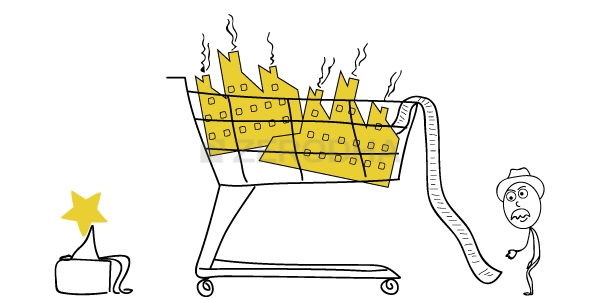
How do you calculate the cost of good sold using Cost of Material Consumed, Purchase of Stock-in-Trade and Changes in inventories of Finished Goods & Work-in-Progress?
COGS is usually associated with the cost incurred for the manufacturing the end product. Have explained it here, please refer section 13.3.
Hi Karthik, I have been following this website religiously, making notes and trying to absorb each and every chapter. I had a question, I could not locate the split of the line items in the financial results. For e.g. “Other Income”, where can we find a split of such things? Can you help?
Usually, the company will associate a note or a schedule for every line item, including Óther Income. Can you please double check for that note once again?
Hello sir,
You doing a Good job to teach everybody in free of cost…..sir I want to know that have you any hardcopy of this book….if you have plz shre how I’ll got.
Thanks and regards
Nitin dey
9969240114
No hard copy of this book, Nitin. We have PDFs though, which you can download and use.
Great job, salute you people. You are spreading the knowledge ,without any cost and your blogs are easy to read and understand. Thank you.
Thanks, Abhishek. Good luck and happy learning!
where can i find this pdf?
Scroll to the end of the page – https://zerodha.com/varsity/module/fundamental-analysis/ and click on download PDF.
Having the same question what Gurjot asked is that how can i find COGS from Cost of Materials Consumed, Purchases of Stock-in-trade, Changes in Inventories of Finished Goods and Work-in-progress ?
And i also checked section 13.3 i.e Understanding the business but can’t find it, pls help me solve this
COGS is a P&L item, add up these things and you will get the COGS.
Thank you so much Karthik. Your content really help all of us.
Good luck and keep going!
In “Change in inventory of goods” I could understand that negative number indicates, company sold products manufactured last year and hence those many products which were manufactured this year are not sold, hence the cost of that extra goods is subtracted from total expenses this year. I have got two questions. 1) Does the positive number indicate that, all the products produced this year are sold and also the remaining products of last year? In such a case will previous year manufactured expenses not be included in the previous year P&L expenses? 2)Does a zero indicate that company was able to sell all the products manufactured?
The P&L statement is supposed to give a sense of proportion. A negative number here represents that the company produced more products than it managed to sell. For example assume they manufactured 100 batteries with the cost of manufacturing each battery as Rs.50. So the total expense is 5000/-. However if they managed to sell only 80 batteries out of the 100, then they will have to show the expense of manufacturing only 80 batteries. Hence they will deduct 20*50 = 1000 from 5000 to give a sense of proportion. Because they are deducting this number it will bear a -ve sign.
Assume the next year they manufacture another 100 batteries at the same cost of Rs.5000. Also assume they manage to sell these 20 extra batteries along with the 100 batteries, then for that year they will have to add the total expense as Rs.5000 and Rs.1000. Because this number has to be added back it bears a +ve sign.
Then in the next year the 20 batteries cost will be added in the “purchase of stock in trade” am I right? What is the difference between Finished goods and stocks in trade?
Yes. Thats right and it will be a +ve number.
Finished goods are inventory that is ready to be sold. Stocks in trade usually refer to material that aids in such sales.
Purchase of stock in trade finished goods directly purchased….the 20 batteries aka closing stock of finished goods becomes opening stock the next year its not added to purchase of stock in trade!!!!!!!!!!!(something which is purchased but not sold is added to inventory later the next year it is treated as opening stock….cogs=os-cs)
Thanks for the comments Manoj 🙂
*** Purchase of stock in trade is the finished goods directly purchased (would love it if there was an edit button)
I know what you mean 🙂
Hi karthik,
What is the difference between change of inventory in finished goods and purchase of stock in trade?
It seems to be same.
Not really, Shubham. Someone had the same query, I’d suggest you go through the comments, have explained this earlier as well. Thanks.
Sir, I have added query here. So in case of negative value of COFGS, where we will add the cost of the goods Co has purchased but deferred its cost for future point when those goods will be actually sold. I was also thinking that it will be added in “Purchase of Finished Stock-in-trade” but Manoj comment and your affirmation on that suggests that later is not the cost of Inventories borrowed from last year and sold in this year but something Co purchased some finished good and sold it again. Can you please clarify.
One more query I have, don’t we add Income Tax as part of Taxes so that PAT is actual profit after income tax as well.
Thank & Regards
Yes, PAT excludes the taxes, Dan.
Opening stock- closing stock if it negative then it means it sold more no than manufactured (including previous year) them it should be added to stock in trade current this year like than na sir.
If negative it means the company sold less than what it manufactured, hence to give a sense of proportionality the company reduced this cost from the cost of manufacturing from expenses. Hence it is negative.
Karthik is right…….let me give you an ex opening stock 399, manufactured 1000, closing stock 400 sales=x find x!!!!!!!
opening stock 399
add:manufactured 1000
less :closing 400
=sold 399
change in inventory is -ve(399-400=-1)……goods sold < that manufactured
Like karthik said the company reduces the cost of excess goods & the same is debited to inventory a/c (closing stock) …this is done to comply with the accrual concept of fundamental accounting assumptions of accounting standard 1
* sold=999
Sir. .what do you mean company reduces the cost of excess goods ?
Cost cutting maybe 🙂
I’m uable to think of where I have mentioned this. Can you please point to it? Thanks.
Dear sir u are doing great job.pls explain me how Arbl shareholders equity is 1059 cr for 2013 instead of 10598 cr.pls reply sir.
If you look carefully the numbers expressed in the BS is in Million Rupees, but throughout the module I have converted the numbers to INR Crs. Hence what you see is 10598 Million Rupees which is equivalent to Rs.1059.8Crs.
Thank you sir, i got it.one more doubt about tax rate.how can be calculated?
One quick but dirty technique is to identify this is by dividing Income tax paid by PBT. This will give you a rough idea on how much tax is being paid out.